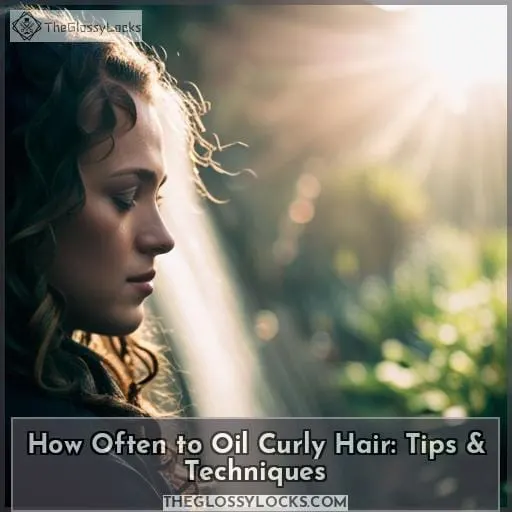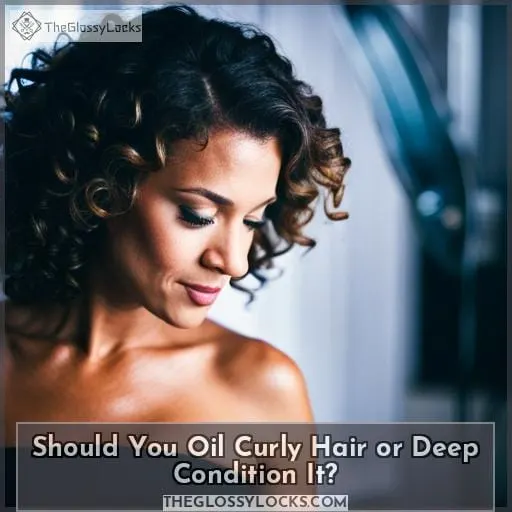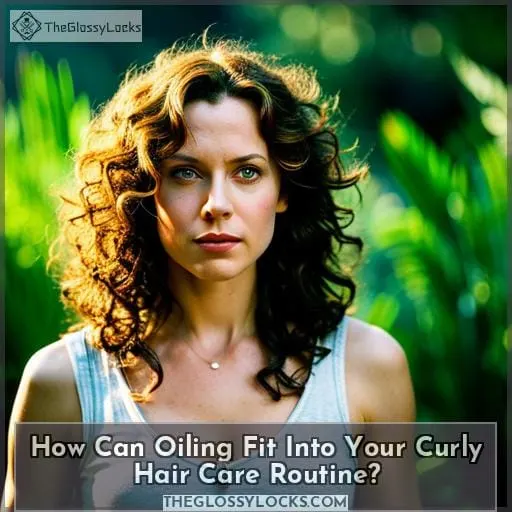This site is supported by our readers. We may earn a commission, at no cost to you, if you purchase through links.
 Curly hair is a beautiful blessing, but it requires special love and attention to stay healthy, hydrated, and shining. One of the most important things you can do is oil your curls regularly – but how often should you oil curly hair? There are several factors to consider, such as your scalp health, porosity type, and texture.
Curly hair is a beautiful blessing, but it requires special love and attention to stay healthy, hydrated, and shining. One of the most important things you can do is oil your curls regularly – but how often should you oil curly hair? There are several factors to consider, such as your scalp health, porosity type, and texture.
Table Of Contents
- Key Takeaways
- How Often Should You Oil Curly Hair?
- How to Avoid Making Curly Hair Greasy While Oiling?
- What Are the Best Oils for Curly Hair?
- Should You Oil Curly Hair or Deep Condition It?
- How Can Oiling Fit Into Your Curly Hair Care Routine?
- What Other Aspects of Curly Hair Care Should You Consider?
- Tips for Styling and Embracing Your Natural Curls
- Conclusion
Key Takeaways
- Curly hair requires regular oiling for proper care.
- Oiling frequency depends on hair type, porosity, and scalp health.
- Dry, brittle curls need 2-3 times weekly oiling, while well-moisturized curls require less.
- Choose the right oils based on hair texture, such as jojoba, castor, or coconut oil.
How Often Should You Oil Curly Hair?
When caring for curly hair, it is important to know how often you should be oiling. Factors such as hair type and porosity, as well as scalp health, can all influence the frequency with which you should apply oil.
Generally speaking, if your curls are dry and brittle, then an application of oil at least 2-3 times a week would be beneficial; however, if your curls are already well-moisturized, then applying a minimal amount of product may suffice.
Factors to Consider (Hair Type, Porosity, Scalp Health)
Depending on your hair type, porosity, and scalp health, you need to tailor the oiling frequency of your curls for optimal results. Porosity considerations should inform how often you apply oils, as well as the ideal combinations for maximum hydration.
Scalp health also impacts oiling frequency; if it is dry or irritated, use a lighter hand when applying oils.
Frequency for Dry, Brittle Hair
If your curls are dry and brittle, you’ll want to oil them up two or three times a week for maximum moisture. To prevent breakage, use moisturizing techniques such as scalp massages with the right oils – jojoba for fine hair, castor and coconut for thick strands.
Oiling tools like wide-toothed combs help distribute product evenly while also providing hydration benefits.
For an overnight routine that seals in nourishment further, braid your hair after application and put on a silk/satin bonnet before bedtime.
Frequency for Well-Moisturized Hair
For those with well-moisturized hair, oiling should be kept to a minimum – just enough to ensure the curls remain hydrated and healthy! Maintaining moisture balance is key; using scalp massages and hydrating techniques can help prevent over-oiling.
Experimentation is essential for finding your personalized oil schedule that fits best with your unique curl needs. Use oils tailored specifically for coarse or fine textures, such as jojoba or coconut respectively, to nourish while avoiding greasiness.
How to Avoid Making Curly Hair Greasy While Oiling?
You can keep your curly hair looking healthy and hydrated with the right oiling techniques. To avoid greasiness, you must learn the proper application technique, use the correct amount of oil for your hair texture and length, as well as consider overnight oiling tips.
Proper Application Technique
To get the most out of oiling your curls, it’s important to know the proper application technique. Common mistakes include not pre-oiling prep, scalp massage, and distributing oil evenly throughout hair strands.
Make sure to choose an appropriate oil for your type of curl; jojoba or argan oils work best for fine hair, while thicker textures may need castor or almond oils. To prevent frizz and retain moisture, use a silk bonnet before bedtime when overnight conditioning is desired.
Using the Right Amount of Oil
A crucial part of caring for curly hair is using the right amount of oil to avoid greasiness. To ensure optimal oiling techniques, focus on preventing over-oiling and effective scalp massage. Variations in the frequency and type of oils can help determine an individual’s needs while keeping their scalp healthy.
Oiling too often will lead to a buildup that results in limp curls without shine or bounce; conversely, not enough oiling won’t allow it to properly seal in hydration and nourishment needed for healthy curls.
Overnight Oiling Tips
Discover how overnight oiling can help keep your curls hydrated and frizz-free. Applying oil to the dry scalp at night, massaging it in, and then covering it with a silk bonnet will provide protection from friction while ensuring maximum absorption of the product.
In the morning, use a gentle rinse technique instead of shampoo to prevent any oil staining on pillowcases or clothes. This method is most beneficial for types 3 & 4 curls, as it prevents dryness while maintaining their shape and definition.
For best results when sleeping in oils, consider protective hairstyles like braids and buns.
What Are the Best Oils for Curly Hair?
Caring for curly hair requires the right oils to keep it hydrated and healthy. Jojoba oil, argan oil, and coconut oil are all excellent choices for nourishing your curls with moisture while maintaining definition and reducing frizz.
Jojoba Oil
Unlock the secret to stunning curls – Jojoba oil! Its light and silky texture penetrates your hair strands like a glove, nourishing them with moisture. It’s packed with benefits like helping define ringlets, reducing frizz, and protecting against styling damage.
Jojoba oil can also be used as an emollient for scalp health. Its lightweight composition is perfect for fine-haired beauties, unlike heavier oils that weigh down locks. Experimenting with jojoba will help you find what works best for your unique curl pattern.
Argan Oil
Reap the invigorating benefits of argan oil to nourish your curls and give them a natural, glossy sheen. Argan oil is high in Vitamin E and fatty acids that penetrate deep into hair follicles to promote healthy growth.
Plus, it’s lightweight, so it won’t weigh down fine or thinning hair like other oils may do.
So go ahead, treat yourself (and your curls) with some indulgent pampering using argan oil today – they’ll thank you later!
Coconut Oil
Treat your curls to the nourishing power of coconut oil, a lusciously hydrating remedy that can unlock bouncy and defined strands. For optimal results, apply it directly to the scalp for deep hydration or as an overnight treatment.
Coconut oil benefits include:
- Restoring moisture in dry tresses
- Enhancing curl definition
- Reducing frizz
- Providing protection against environmental damage
For those who don’t want to use oils, there are alternatives such as conditioners or moisturizers which provide some of the same benefits when applied correctly with minimal product buildup on the scalp and hair shafts.
No matter what you choose, be sure not to make common curly hair care mistakes like using too much shampoo or washing too frequently – both will strip away precious nutrients from your delicate locks!
Should You Oil Curly Hair or Deep Condition It?
When it comes to caring for curly hair, oils and deep conditioning are both essential tools. Oils moisturize and seal the scalp, while deep conditioners restore lost hydration. Finding the right balance between oiling and conditioning is key for healthy curls that look great all day long.
The Role of Oils in Moisturizing and Sealing
By utilizing oils to moisturize and seal your curls, you can ensure lasting hydration and strength. Oiling myths abound; however, learning the correct sealing techniques for your hair texture is key. Proper oil application prevents product build-up while nourishing scalp health with natural oils like jojoba, argan, or coconut.
Moisturizing methods should be tailored to individual needs, as over-oiling can lead to greasy strands instead of soft ones! To achieve optimal results in terms of moisture retention and curl definition without sacrificing shine or movement, incorporate a well-balanced oiling and deep conditioning routine into your regular hair care regimen.
The Benefits of Deep Conditioning
Discover how deep conditioning can transform your curls and give them life! A quality deep conditioner provides the necessary hydration to keep your hair elastic, strong, and less prone to breakage.
Select a product that is tailored for type 3 curly hair – natural ingredients like shea butter are great for nourishing strands without weighing them down. When it comes to shampooing frequency, remember that too much can strip away essential oils on top of reducing the benefits from deep conditioning treatments.
Try alternating between oiling applications and hydrating with a weekly mask or lighter in-shower treatment as part of an overall curl care routine; this combination will improve strength while providing shine-enhancing moisturization you’ll love!
Finding the Right Balance
Achieving a balance between oiling and deep conditioning is key to keeping your curls healthy. In fact, experts suggest that curly hair should be conditioned twice as much as it is oiled! Common mistakes include over-oiling or not taking porosity into account.
For scalp health, use lighter oils like olive or castor for well-moisturized hair. When oiling techniques are done correctly with the right products, they can help maintain optimal levels of sebum production and prevent scalp issues.
Hydration tips, such as overnight oil treatments with natural ingredients like coconut or almond, can provide extra nourishment for dry locks while avoiding greasiness.
How Can Oiling Fit Into Your Curly Hair Care Routine?
Finding the right frequency and incorporating overnight oiling into your curly hair care routine can be tricky, but balancing it with deep conditioning is key. Knowing when to use oil properly and how much of it will make all the difference in caring for your curls.
Finding the Right Frequency
Finding the right frequency for oiling your curls can be tricky; it all depends on your individual hair needs. Factors such as scalp health, moisture balance, and deep conditioning should all be taken into consideration when deciding how often to oil type 4 hair.
Hydration techniques like overnight oiling will help prevent breakage while providing nourishment for healthy growth without over-oiling.
Incorporating Overnight Oiling
Experience the ultimate in hydration and curl definition by trying a luxurious overnight oiling routine! Start by picking the right oil for your hair type. When applying to roots, make sure you’re massaging it into your scalp before spreading it throughout the lengths of your strands.
Place a silk or satin bonnet on your head to prevent pillow stains while allowing for maximum hydration absorption overnight.
Tailor the oils based on your hair texture. Jojoba, argan, and coconut are great options to consider. Experiment until you find what works best for you. Remember to balance out this treatment with regular deep conditioning sessions too.
Balancing Oiling With Deep Conditioning
Discovering the perfect balance between oiling and deep conditioning is key to unlocking hydrated, healthy curls. To achieve this harmony, you must be mindful of moisture management. Use natural oils such as Argan or Almond Oil to nourish and hydrate your hair without clogging pores.
For finer hair types, opt for lightweight options like Jojoba Oil that won’t weigh down strands, while heavier oils like Coconut can help correct sebum imbalances in coarser textures.
Maintaining a consistent routine will ensure optimal results over time! Find what works best for you by experimenting with different conditions and amounts of oil until you find the right combination for lasting luscious locks.
What Other Aspects of Curly Hair Care Should You Consider?
When it comes to caring for curly hair, there are many important details to consider beyond oiling. Choosing the right shampoo and conditioner that caters specifically to your individual needs is essential in maintaining a healthy scalp and hair growth.
Conditioners help seal the cuticle effectively, locking in moisture while protecting your curls from environmental damage caused by heat styling or external elements. Hair masking also plays an important role as it helps replenish lost nutrients and minerals; trimming split ends regularly will aid in preventing further damage as well.
Choosing the Right Shampoo
When it comes to keeping your curls healthy, selecting the right shampoo is key. Scalp health management involves using sulfate-free options and clarifying choices that leave hair feeling clean without stripping away natural oils.
pH balancing products help lock in moisture, while hydration techniques like pre-shampoo treatments provide extra nourishment for dry locks.
Look for formulas that are compatible with oiling routines and contain ingredients such as jojoba, argan, coconut oil, castor seed oil, or almond butter. These ingredients promote curl definition and reduce frizz. You can create a tailored routine designed especially for you by combining these products.
Using Conditioner for Sealing and Protection
After shampooing, conditioner provides a sealant to lock in moisture and protect your curls. Conditioners offer a range of benefits, including breakage prevention, improved elasticity, hydration retention, and curl definition.
For optimal results, apply the conditioner from mid-lengths to ends for maximum protection. Use only enough product to ensure every strand is coated, yet not weighed down or greasy-looking. When applying the product, make sure it’s evenly distributed throughout strands with minimal buildup on the scalp area.
Lastly, avocado oil can be used periodically between washes as it helps strengthen curls while keeping them soft and supple for longer periods of time – perfect if you’re trying out different styles without fear of breakage!
Hair Masking and Trimming
Try out weekly hair masking to treat your curls with nourishment and hydration, while regular trimming keeps them looking vibrant. Make use of natural ingredients for homemade masks that target your specific needs.
Prevent split ends by cutting off the damaged ends regularly and include a nighttime routine such as the pineappling technique to maintain healthy curls. Additionally, balance conditioner usage with oiling as it helps seal in moisture without being too greasy or heavy on strands.
Don’t forget that a trim every few months is critical for maintaining length and shape! With these tips, you can bring life back into fragile curly hair while also embracing its unique beauty through hairstyles like updos or French plaits!
Tips for Styling and Embracing Your Natural Curls
It’s time to embrace your natural curls and experiment with different techniques! From updos, ultra-high ponytails, side braids, messy half buns, and French plaits to twists – there are a plethora of curly-friendly hairstyles you can try.
Whether it’s using the right oils or finding the perfect styling products for your hair type – discovering what works best for you is an important part of caring for your unique curls.
Curly-Friendly Hairstyles
Show off your gorgeous curls with a variety of curly-friendly hairstyles, such as an updo, ultra-high ponytail, side braid, messy half buns, and French plaits!
For ultimate curl definition and frizz reduction, try protective styles like braids or twists.
You can use heat styling if you protect your hair with a heat protection spray beforehand.
To keep volume in check between washes, oil up your scalp – use jojoba or argan oils for best results.
When it comes to nighttime routines, pineappling is the key to maintaining bouncy curls without any damage.
Embracing Your Unique Curls
Embrace your natural beauty by rocking a hairstyle that highlights your unique curls. Whether it’s an updo, ultra-high ponytail, side braid, or twisted half buns, finding the style that best suits you and boosts confidence can be challenging.
Curly hair reacts differently to weather, styling products, and cultural influences.
A nighttime routine involving pineappling with a satin bonnet also helps keep curls hydrated while protecting them from breakage. Get creative! Utilize wide-toothed combs for detangling without damaging strands and experiment with different oils tailored to specific textures for nourishment and frizz reduction.
Empower yourself through styling – let go of comparisons and celebrate who you are!
Experimenting With Different Techniques
Discovering your unique styling routine is key to unlocking the potential of your curls. Experiment with curl-enhancing oils and different oil application methods to find out what works best for you.
Boost circulation and help distribute oil evenly by giving yourself scalp massages.
To detangle split ends without causing damage, use a dry bristle brush or a wide-toothed comb.
Choose an oil that is tailored to your curl type. For fine hair, try grapeseed oil.
Conclusion
It’s time to embrace your natural curls! Oiling your hair is an essential part of caring for curly hair, but how often should you do it? Well, it depends on your hair type, porosity, and scalp health.
For dry, brittle hair, oiling 2-3 times a week is recommended. For well-moisturized hair, use minimal oil. Jojoba, argan, and coconut oil are the best oils for curly hair, but tailor your selection to your hair texture.









